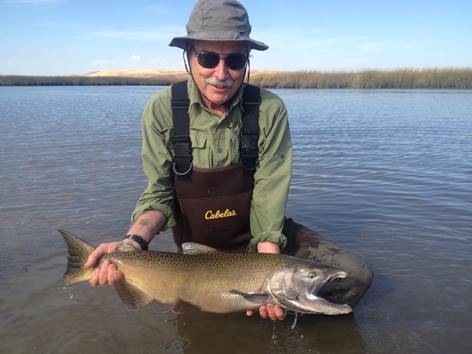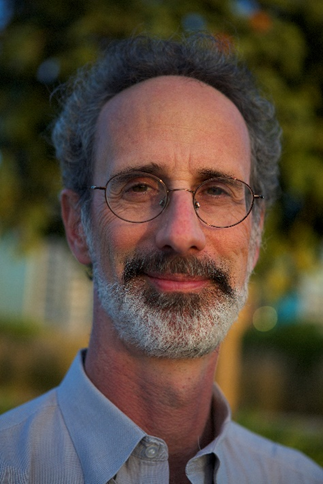KEYNOTE/PLENARY SESSIONS
(Updates still occurring, more information to come!)

Mary Power
Drought, floods, and alternate states of algal-based river food webs in the Thirsty Eel
Winter scour and summer base flow control algal-based food webs that assemble during the biologically active summer in the Eel and similar rivers under the Mediterranean seasonality along the California North Coast. Large algal blooms of the macroalga Cladophora follow winters with one or more bed-mobilizing flood, which scour away over-wintering armored grazers. Inedible armored grazers abound after winters without flood scour, and sequester early summer growths of Cladophora and diatoms, reducing supplies for higher trophic levels. If winter floods release spring algae from large grazers, however, Cladophora proliferates over the summer low flow season, and becomes overgrown with highly edible epiphytic diatoms. Salmonids and other predators are then supported by prey built of epilithic and epiphytic algal carbon, but only if scouring winter floods are followed by sustained summer base flow. If prolonged drought (or human water extraction) reduce flows enough to disconnect and warm mainstem pools, cyanobacteria, some toxic, can proliferate and cover both rocky substrates and the Cladophora-diatom assemblages. Twenty-five years of observation, 5 field experiments, and diatom frustule counts in an 84-year stratigraphic record from the Eel’s marine canyon help link year-to-year variation in hydrology to the three contrasting summer food web states: with scouring floods and sufficient summer baseflow leading to 3-4 link chains that support salmon; flood-free winters leading to 2-link food chains with algal energy sequestered by predator resistant grazers if base flows keep mainstem reaches hydraulically connected; and the recently seen, concerning development that under severely reduced summer baseflows, a one-link food chain may develop, capped by cyanobacteria, some of which are toxic to vertebrates. Agency, academic, and citizen scientists are now collaborating to monitor and study conditions that flip river food webs from salmon-supporting to cyanobacterially-dominated states, and to learn more about the fates of algal production in river and coastal food webs. More Eyes on the Eel and other rivers are needed to track critical flow-driven ecological changes, and to steward watersheds through the altered hydrologic regimes that lie ahead.
Dr. Mary E. Power is Professor in the Department of Integrative Biology at the University of California, Berkeley. She was awarded an honorary doctorate by Umea University, the Kempe Medal for distinguished ecologists, and the Hutchinson Award from the American Society of Limnologists and Oceanographers. She is a member of the California Academy of Science, the American Academy of Arts and Sciences, and National Academy of Sciences, USA. She has served on the Editorial Board of PNAS (2014 to present) and Science (2006-2009). Mary also served as President of the American Society of Naturalists, and of the Ecological Society of America. Since 1988, she has been the Faculty Director of the Angelo Coast Range Reserve, (one of the UC Natural Reserve System sites, a 3500 ha reserve protected for university teaching and research). She has studied food webs in temperate and tropical rivers, as well as linkages of rivers, watersheds and near-shore environments. Focal organisms include cyanobacteria, algae, invertebrates, fish, estuarine crustaceans and terrestrial grasshoppers, spiders, lizards, birds and bats. By studying how key ecological interactions depend on landscape and temporal contexts, her group hopes to learn how river-structured ecosystems will respond to changes over space and time in climate, land use, and biota. Her group also collaborates closely with Earth and atmospheric scientists in site-based research to investigate linkages among riverine, upland, and near-shore ocean ecosystems.

Peter B Moyle
Aquatic California: endemic biota, endemic problems, endemic solutions
Center for Watershed Sciences and Department of Wildlife Fish and Conservation Biology, University of California, Davis
California is distinctive aquatic bioregion, with a high degree of endemism in its biota. The best-studied group, the fishes, is 79% endemic to the state or adjacent regions. Endemic species are widely distributed around the state but most are concentrated in ‘hot spots’. Aquatic invertebrates follow the same pattern. California is the hydraulic society, so there is intense competition between humans and aquatic ecosystems for water. The ecosystems are losing. Most are highly altered and/or highly invaded by alien species, creating novel ecosystems. As a result 93 of 124 extant native fishes have some official designation as endangered, threatened, or special concern. Such severe stress requires new approaches and large-scale solutions. 'Reconciliation ecology' is an approach that seems to resonate with managers and can provide a basis for state-wide conservation strategies that are broad in scope but local in impact.
Peter Moyle has been working on the ecology California's freshwater and estuarine fishes since 1969, culminating in Inland Fishes of California (2002, UC Press). He has co-authored numerous papers on the ecology, status and trends of California’s native and alien fishes, including documenting declines of salmon, steelhead, and other anadromous fishes in California. Present research focuses on climate change, effects of drought on fishes, floodplain management, and reconciliation ecology. He is Distinguished Professor Emeritus in the Department of Wildlife Fish and Conservation Biology and associate director of the Center for Watershed Sciences, UC Davis.

Peter Gleick
The future of freshwater in a world of climate change
Global and local freshwater challenges continue to mount around the world as populations expand, economies grow, and climate changes accelerate. Dr. Peter Gleick will address the nature of freshwater problems, the history and science around society's efforts to solve water challenges, and a vision for a sustainable future for water. Science and technology remain central to efforts to understand and improve water management, but it is equally important to understand the economic, cultural, and political factors that also influence how freshwater is used and how the adverse impacts of that use can be mitigated.
Dr. Peter Gleick is a leading expert, innovator, and communicator on water and climate issues. He co-founded and leads the Pacific Institute in Oakland created in 1987 and now one of the most innovative, independent non-governmental organizations addressing global water challenges. Dr. Gleick's work has redefined water from the realm of engineers to the world of social justice, sustainability, human rights, and integrated thinking. His influence on the field of water has been long and deep: he developed one of the earliest analyses of climate change impacts on water resources, the earliest comprehensive work on water and conflict, and defined basic human needs for water and the human right to water – work that has been used by the UN and in human rights court cases. He pioneered the concept of the "soft path for water," developed the idea of "peak water," and has written about the remarkable history and background of the growing bottled water phenomenon. Dr. Gleick is a MacArthur "genius" Fellow, was named "a visionary on the environment" by the BBC, and is an elected member of the U.S. National Academy of Sciences. Wired Magazine featured Dr. Gleick as "one of 15 people the next President should listen to." He received his B.S. from Yale University and an M.S. and Ph.D. from the University of California, Berkeley. Dr. Gleick serves on the boards of numerous journals and organizations, and is the author or editor of many scientific papers and eleven books, including the influential series The World's Water and Bottled and Sold: The Story Behind Our Obsession with Bottled Water, as well as the 2012 release A Twenty-First Century U.S. Water Policy.

Angus Webb
Of droughts and flooding rains: innovative responses to water scarcity in temperate AustraliaThe Millennium Drought (1997-2009) across much of temperate Australia caused major hardships in rural communities and long-lasting (perhaps permanent) damage to river systems of the Murray-Darling Basin and beyond. However, with every crisis comes opportunity, and the latter years of the Millennium drought were characterized by rapid advances in water resource and environmental management research, policy and practice in Australia.
Rare bipartisanship in the nation's capital saw a new Federal Water Act established, greatly increasing the standing of 'the environment' as a legitimate user of water. The Murray-Darling Basin Plan, which became law in November 2012, will see around 2,750 GL/year of water recovered from consumptive water uses (mainly irrigation) for the environment. This equates to a recovery of around 21% of average annual discharge across the Basin. This make it one of the largest (in terms of relative volumes) environmental flows program ever implemented, and positive ecological responses of this major investment in the environment are already being observed. However, water reform has been far from painless, with affected rural communities understandably concerned about effects upon their livelihoods, and indeed the long-term viability of the fabric of rural Australia.
During the drought, technological and behavioural innovations greatly reduced water consumption in urban and rural Australia; and local river managers developed ecological triage approaches to maintain critical ecological functions of rivers on very small volumes of water. Water markets have also created the opportunity for efficient use of water for both consumptive and environmental purposes; and collaborations between researchers and river managers are developing methods to achieve best ecological outcome from the environmental water available.
The drought broke with a bang, with record flooding in south-eastern Australian in spring 2010, and rainfall patterns have been approximately average since then. Encouragingly, the majority of water reform policies and practices have endured, suggesting that Australia is better placed to face the next major drought. An opportunity to test this hypothesis may come sooner than expected, with 2015 inflows to the Murray River through to the end of September among the lowest on record, and climatic conditions in the Pacific and Indian oceans pointing to the high likelihood of a dry 2016.
Biography
Dr Angus Webb is a Senior Lecturer in Environmental Hydrology and Water Resources at the University of Melbourne, Australia. He originally trained as a marine ecologist before moving into the study and restoration of large-scale environmental problems in freshwater systems. Much of his research centers on improving the use of the existing knowledge and data for such problems. To this end he has developed innovative approaches to synthesizing information from the literature, eliciting knowledge from experts, and analyzing large-scale data sets. He is heavily involved in the monitoring and evaluation of ecological outcomes from the Murray-Darling Basin Plan environmental watering, leading the program for the Goulburn River, Victoria, and advising on data analysis at the basin scale. Angus is currently a co-editing a major new text book on environmental flows science and management. He was awarded the 2013 prize for Building Knowledge in Waterway Management by the River Basin Management Society, and the 2012 Australian Society for Limnology Early Career Achievement Award.

